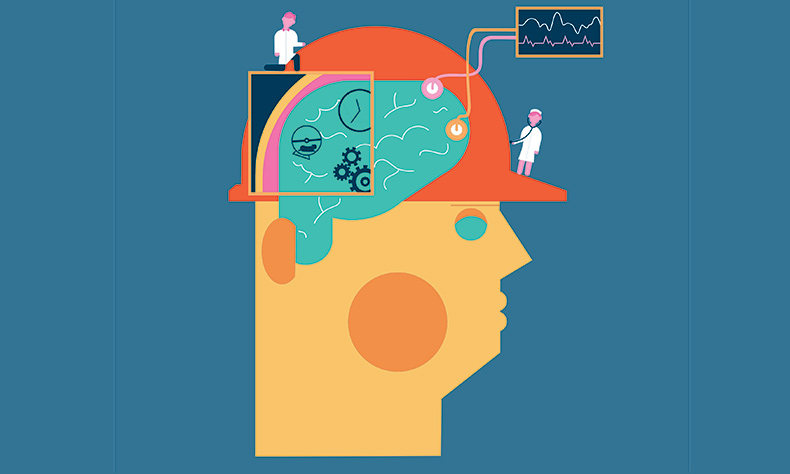Speaking Up
Mental health is a big issue in the workplace – especially in male-dominated professions like constructio
by Martin Dover

When it comes to mental health, it turns out that men and women can’t claim an even playing field. “Men are different from women in this way,” says Dr. JianLi Wang, a researcher and professor at the University of Calgary. “They are reluctant to share their emotional experiences with their family, or employers or co-workers.”
For years, Wang has been studying mental health in the workplace. A professor in the U of C’s department of psychiatry, he is keenly aware of the mental health challenges that arise in the workplace – and especially in male-dominated fields like construction.
Construction is unique: “Even in Alberta, it’s even more unique now if you think about the boom and bust cycle,” says Ione Challborn, executive director of the Canadian Mental Health Association, Edmonton Region. “Job security is a big issue, so whether you have a job or you don’t, or you’re worried about losing one, there’s a high degree of stress and anxiety.” Pair that with the industry’s relatively higher rates of addiction and on-the-job injury, and you’ve got a field primed for mental health issues.
“The industry is highly male-dominated, which often corresponds with not wanting to talk about problems,” says Challborn. “But the age most at risk for suicide is middle-aged men.”
Wang believes that the most important steps that businesses within the construction industry can take are to raise awareness, and through that, create an environment where people can openly discuss their problems. “We had an employer who said that it was pretty easy to see who was going through emotional issues, but that everyone had different coping strategies,” he says. “Not everyone is proactive.”
“So many employers have been very rigorous about developing physical safety standards,” adds Challborn. “To be able to develop the same comprehensive mental health programs would be leading edge.”
If you’re an employer, the trick is to keep your eyes open. “If you notice someone having reduced productivity or job performance, there may be something going on there,” says Wang. “If their interests are not there anymore, that’s a sign to talk to them and find out what’s going on.”
All of this relies on a strong workplace foundation, he adds. “From our experience in talking to men in the workplace, it depends on your personal relationship with them. They’ll only disclose to a person they trust.”
Wang mentions some successful initiatives that he has seen companies take on – buddy programs, for instance, which match senior workers with new employees. “They might have a regular meeting or coffee break, even just once a month, to talk about what’s happening in their lives. This can help to solve issues beforehand.”
Challborn agrees: “You have to promote a culture of asking people how they are doing, not just what they are doing … to get away from that traditional, male way of just sucking it up.”
Wang and his team are working to develop a risk prediction algorithm – basically a website that members of the general public can use to monitor and determine their own personal risk of developing major depression in the future. It’ll be open access, available to all, and will incorporate his broader findings in terms of anxiety and workplace depression triggers and evidence-based solutions for handling specific incidents.
Depression affects everyone, no matter their position or stature in the workplace, and early prevention is something that Wang and Challborn both agree on. “Whenever you feel so much stress, talk to people and don’t hold it internally,” says Wang.
Fast Facts about Mental Health
WHO IS AFFECTED?
- 20% of Canadians will personally experience a mental illness in their lifetime.
- Mental illness affects people of all ages, educational and income levels, and cultures.
- Approximately 8% of adults will experience major depression at some time in their lives.
HOW COMMON IS IT?
- Schizophrenia affects 1% of the Canadian population.
- Anxiety disorders affect 5% of the household population, causing mild to severe impairment.
- Suicide accounts for 24% of all deaths among 15- to 24-year-olds and 16% among 25- to 44-year-olds.
- The mortality rate due to suicide among men is four times the rate among women.
WHAT IS THE ECONOMIC COST?
- Including health care costs, impacts on productivity, and reductions in quality-of-life, the economic cost to Canada of mental illness was about $42 billion per year in 2011. (Source: http://www.mentalhealthcommission.ca/sites/default/files/MHCC_Report_Base_Case_FINAL_ENG_0_0.pdf)
- An additional $6.3 billion was spent on uninsured mental health services and time off work for depression and distress that was not treated by the health care system.
Challborn suggests employers download and review the Mental Health Commission of Canada’s health and safety standards, which can help improve productivity, financial performance and employee retention. Download for free at:
www.mentalhealthcommission.ca/English/national-standard
Source: cmha.ca
